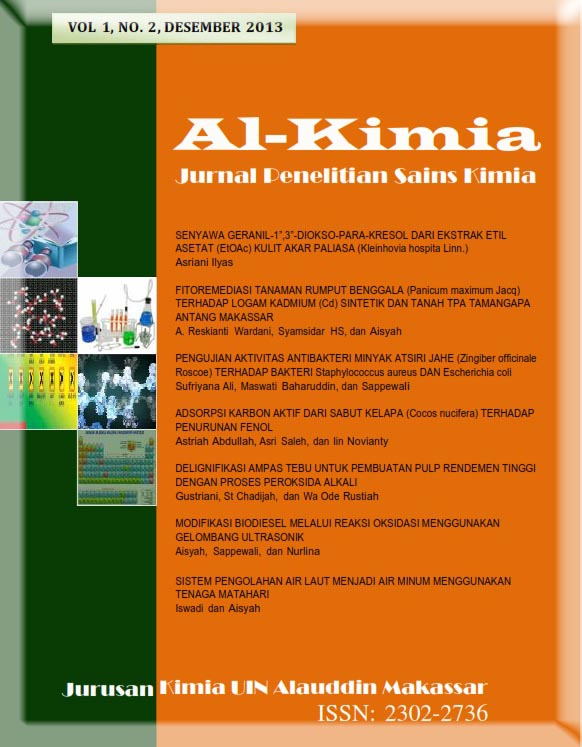Sistem Pengolahan Air Laut Menjadi Air Minum Menggunakan Tenaga Matahari
Abstract
Has done research about the system of purification of sea water into drinking water using solar energy. Utilization of solar energy as power naturally adopts the system of evaporation that occurs in a siklur water. Design and construction of tools created in the shape of a pyramid so that the absorption of thermal energy from the Sun can be maximum. Methods of work of the system is very simple, namely the souls imprisoned in the air that the pyramid would experience an increase in temperature significantly along with the searing Sun. The temperature of the hot air in the space pyramid is causing sea water which is at the bottom (floor) pyramid will evaporate and stick on the wall side of the inside of the pyramid. With the help of gravity, the water vapour will fall in the form of green ears water down the wall of the pyramid. The water will flow through the channel leading into the shelter is. This water is not already contain salt and pure water is so that it can be consumed directly. The results showed that the pyramid with size 160 cm x 160 cm 3 mm fiberglass-wall capable of producing fresh water as much as 2,100 mL. These results have been tested in the laboratory with a result salinity = 0,0 at T = 29,4 °C; TDS = 11 mg/L, 22.2 ms/cm conductivity, at T = 29.3 °C, no taste and no smell.Downloads
References
Clasen, T.F. & Haller, L., 2008, Water Quality Interventions To Prevent Diarrhoea: Cost and Cost-Effectiveness, Geneva: WHO Press. Crittenden, J. C. et al., 2012, MWH’s Water Treatment: Principles and Design, Third Edition, John Wiley & Sons.
Fewtrell, L., et al., 2005, Water, Sanitation, and Hygiene Interventions to Reduce Diarrhoea in Less Developed Countries: A Systematic Review and Meta-Analysis, Lancet Infectious Deseases.
François Brikké dan Maarten Bredero, 2003, Linking Technology Choice with Operation and Maintenance in the Context of Community Water Supply and Sanitation, WHO and IRC Water and Sanitation Centre, Geneva, Switzerland.
Gundry,S., Wright, J., dan Conroy, R, 2004, A Systematic Review Of the Health Outcomes Related to Household Water Quality in Developing Countries. Journal of Water and Health. 02 (1), Online, http://www.faktailmiah.com/2010/07/02/siklus-air.html (Diakses 18 Maret 2014).
Letterman, R. D., 1999, Water Quality and Treatment A Handbook of Community Water Supplies: American Water Works Association. Fifth Edition. USA. McGRAW-HILL, INC.
Peraturan Menteri Kesehatan R.I No : 416/MENKES/PER/IX/1990 tentang Daftar Persyaratan Kualitas Air Minum. Jakarta 1990.
Peraturan Pemerintah No. 20 Tahun 1990 tentang Pengelompokan Kualitas Air Menjadi Beberapa Golongan Menurut Peruntukannya. Jakarta 1990. WHO & UNICEF, 2005, Water for Life: Decade For Action 2005-2015, Genewa. WHO & UNICEF, http://www.watersecure.com.au.
Desalination – fresh water from the sea, (Diakses:20 Maret 2014).
Vousvouras, C. A. dan Heierli, U., 2010, Safe Water at the Base of the Pyramid How to involve private initiatives in safe water solutions. http://www.300in6.org. (Diakses 20 Maret 2014).
Authors who publish with this journal agree to the following terms:
1) Authors retain copyright and grant the journal right of first publication with the work simultaneously licensed under a Creative Commons Attribution License that allows others to share the work with an acknowledgement of the work's authorship and initial publication in this journal.
2) Authors are able to enter into separate, additional contractual arrangements for the non-exclusive distribution of the journal's published version of the work (e.g., post it to an institutional repository or publish it in a book), with an acknowledgement of its initial publication in this journal.
3)Authors are permitted and encouraged to post their work online (e.g., in institutional repositories or on their website) prior to and during the submission process, as it can lead to productive exchanges, as well as earlier and greater citation of published work (See The Effect of Open Access).


